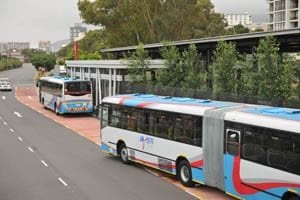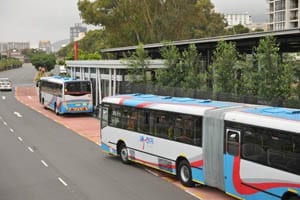Modernised minibus-taxi industry
Apart from passenger rail, the MyCiTi service, and a contracted quality bus service, the business plan identifies the minibus-taxi industry as pivotal in establishing a fully integrated public transport system in Cape Town. “In fact, we foresee that by formalising and modernising the minibus-taxi industry, the operators will become our partners in transforming the method and ease of commuting in Cape Town. As such, the IPTN Business Plan states that minibus-taxis will provide on-demand services in future MyCiTi service roll-outs and transport commuters to stations and stops from where commuters can transfer to a MyCiTi trunk route which operates on dedicated right-of-way red roads,” said Herron. Associated infrastructure and the MyCiTi system will therefore be designed to facilitate transfers between minibus-taxis and MyCiTi services.“The reason for this major shift is that we have learned that removing minibus-taxis along routes where the MyCiTi service is operating, such as in Phase 1, is financially unsustainable in the long-term,” explains Herron.
The objective is to develop a hybrid-model which uses the strengths of the minibus-taxi industry to deliver an improved MyCiTi service at a cost that is affordable to the City and commuters. Importantly, the IPTN Business Plan takes into account the impact of emerging new generation services which are revolutionising public transport across the world. Once all public transport vehicles are tracked in real time in a single system, mobile device applications can be developed to enable a user to see a route, mode and price options in real time, including details of transfers between modes and total trip time options. It also allows users to track, in real time, the vehicle they need to catch so that they can get to the required station or stop in time. “Going forward, the City will also investigate how innovative information technologies can assist us in creating a convenient, secure, and cost-effective fare system that facilitates integration across all of the modes, including parts of the minibus-taxi industry,” said Herron. Importantly, minibus-taxi operators can benefit greatly from emerging new generation services. Through e-hailing, minibus-taxi operators will benefit from lower costs, less congestion, and increased passenger numbers. Commuters will also benefit as it will make it a lot easier to catch a minibus-taxi. The IPTN Business Plan outlines the City’s intention to develop a new generation of public transport services by capitalising on emerging e-hailing and other technologies over time. This way the City can improve the integration between all scheduled public transport services such as the MyCiTi service, rail, other quality bus services, and minibus-taxis, and create demand-responsive services.







